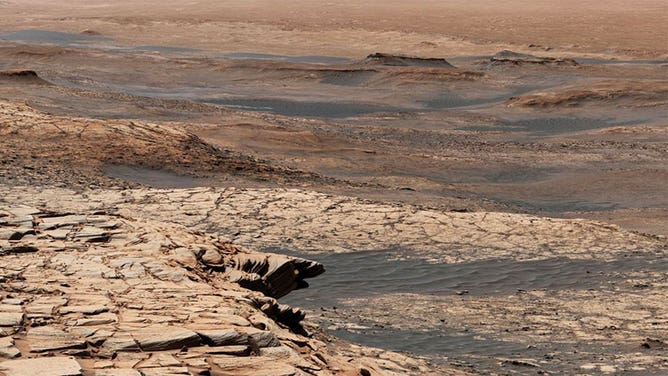'Higher potential for life': Researchers find topographical evidence of ancient shoreline on Mars
Using data from a satellite orbiting the Red Planet, researchers said they have found evidence that a large ocean once existed in its northern hemisphere.

Stitched together from 28 images, this view from NASA's Curiosity Mars rover was captured after the rover ascended the steep slope of a geologic feature called "Greenheugh Pediment." In the distance at the top of the image is the floor of Gale Crater, which is near a region called Aeolis Dorsa that researchers believe was once a massive ocean.
(NASA/JPL-Caltech/MSSS)
Researchers said they have found evidence of an ancient shoreline on Mars that indicates a large ocean once existed in the northern hemisphere of the Red Planet.
In a NASA-funded study published earlier this month in the Journal of Geophysical Research: Planets, scientists at Pennsylvania State University and the California Institute of Technology said they used data from a NASA satellite orbiting Mars to develop topographic maps of a region called Aeolis Dorsa.
'CONTINENT-SIZE' DUST STORM TAKES OUT NASA'S SEISMIC STATION ON MARS
Analysis of the data revealed about 4,000 miles of fluvial ridges – landforms that are shaped by the action of water – that are likely eroded river deltas or channels carved by underwater currents. A half-mile-thick area of sediment accumulation was also found in the region. These features are indicative of a shoreline.
"The rocks in Aeolis Dorsa capture some fascinating information about what the ocean was like," Benjamin Cardenas, assistant professor of geosciences at Penn State and lead author of the study, said in a statement. "It was dynamic. The sea level rose significantly. Rocks were being deposited along its basins at a fast rate. There was a lot of change happening here."
NASA'S MARS PERSEVERANCE ROVER FINDS DIVERSITY, HINTS OF MICROBIAL LIFE IN ANCIENT LAKE BED ROCKS

There has long been debate in the scientific community about whether Mars had an ocean in its low-elevation northern hemisphere. Using topography data, a Penn State led research team was able to show definitive evidence of a roughly 3.5-billion-year-old shoreline with substantial sedimentary accumulation, at least 900 meters thick, that covered hundreds of thousands of square kilometers.
(Benjamin Cardenas / Penn State)
Cardenas said the basic science of the study – examining layers of rocks, or strata – is something we’ve been doing on Earth for a while.
"Yes, it sounds like a big claim to say we’ve discovered records of large waterways on Mars, but in reality, this is relatively mundane stratigraphy," Cardenas said in a statement. "It’s textbook geology once you recognize it for what it is. The interesting part, of course, is it’s on Mars."
Cardenas said he hopes this will help NASA find areas of Mars where life may have existed.
HEAR AND SEE THE 'RARE' IMPACTS AFTER LARGE METEOROID HITS MARS
"What immediately comes to mind as one the most significant points here is that the existence of an ocean of this size means a higher potential for life," Cardenas said. "It also tells us about the ancient climate and its evolution. Based on these findings, we know there had to have been a period when it was warm enough, and the atmosphere was thick enough to support this much liquid water at one time."
According to Cardenas, this region would be a great place for NASA to study for signs of life since it would be an area where water from the highlands would have likely dumped nutrients into the sea.
"If there were tides on ancient Mars, they would have been here, gently bringing in and out water," Cardenas said. "This is exactly the type of place where ancient Martian life could have evolved."